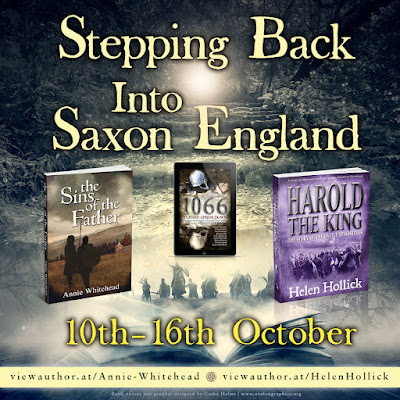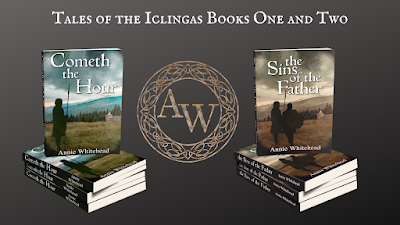Well, you know, if your interest is pre-Conquest England, there’s nothing left to see of that period but empty fields, right? Wrong. (Although yes, it’s true, I do spend a lot of time in fields.)
Helen’s Wednesday guest spot is all about wandering, so as part of our mini tour through Saxon England and its history, I thought I’d take you on a whistle-stop tour of some of the places I’ve been where I’ve felt a real connection to the people whose stories I write.
I’ll start with some buildings - yes, actual buildings. The main reason there’s so little of Saxon England left to see is that they mainly built with wood, which hasn’t survived. But religious buildings, especially in the later part of the period, were built in stone. And there are some beautiful examples still standing.
Escomb
Sitting these days rather incongruously surrounded by modern housing in a little village in County Durham is this extraordinary Church. It probably dates from the late seventh century, and it recycled some Roman stone. It has a wonderful sundial on the wall outside and, apart from the porch - a new addition - has survived intact and unmodernised, probably because the rich bishops of Durham lost interest in it and it was never extended.
St Oswald’s, Gloucester
Not far away from Gloucester Cathedral are the remains of St Oswald’s priory. It was originally dedicated to St Peter, but if you know your early medieval history or have read my novels Cometh the Hour and To Be A Queen, you’ll know what happened to Oswald of Northumbria and that his remains were fetched to Mercia by Æthelflæd, Lady of the Mercians. It wasn’t the first time he’d been posthumously re-homed though, as you’ll discover in my new novel, The Sins of the Father. Æthelflæd herself was laid to rest here, next to her husband. This isn’t a field, but I did get incredibly emotional standing on this site and feeling so close to the people about whom I’ve researched and written so much.
Deerhurst St Mary’s and Odda’s Chapel
Visit Deerhurst, also in Gloucestershire, and you get a real two-for-one. Parts of St Mary’s church are the original Saxon building and, again, if you’ve read To Be A Queen I can tell you that this is the chapel where Ethelred goes to pray, where he takes Æthelflæd, and where they sit together in his twilight years. When I visited, I had the place to myself and the sense of calm was overwhelming. It’s still a working church and the connection with the past is almost palpable. In the book I mentioned the carving of the Madonna above the door, and the ‘angel’ on the outside wall, and here are my photos of them.
Less than a stone’s throw from the church is Odda’s Chapel. Odda was a later earl of Mercia who, despite the assertions of some guide books and websites, was not related to Earl Ælfhere, or Alvar as I called him in my novel, Alvar the Kingmaker. He built the chapel in remembrance of his brother and the dedication stone reads:
"Earl Odda ordered this royal hall to be built and dedicated in honour of the holy Trinity & for the soul of his brother Ælfric who died in this place. Bishop Ealdred dedicated it on 12 April. The fourteenth year of Edward, king of the English (1056)."
Hexham
Just a quick word about this: if you visit Hexham Abbey be sure to go down to the crypt which dates from the days of St Wilfrid (c. 633 – 709 or 710) who features in both my Tales of the Iclingas novels. And try, as I did, to spend a few moments alone down there. Incredible.
But perhaps I should take you to some of those fields now?
Yeavering
It’s bleak. Even centuries after the settlement was built, the site sits in open countryside, surrounded by huge hills, and a fierce wind blows. Not the obvious spot for a ‘des res’ (desirable residence) but nevertheless it was here that Edwin of Northumbria decided to build (or rebuild; there’s evidence that this site had been in use during an earlier period) a great hall, and excavation has shown that there was also some kind of outdoor ‘amphitheatre’, probably where meetings were held. Bede tells us that Bishop Paulinus baptised Northumbrians in the nearby River Glen. All I can say is that they must have been freezing. Still, standing on this enormous site, hemmed in by the hills of the Cheviots, I felt a connection with the man who plays a major part in Cometh the Hour.
Heavenfield
Still in Northumbria, my next ‘field’ is Heavenfield. It’s where Oswald, he whose remains have travelled up and down the country, was said to have erected a wooden cross on the eve of battle. He was Edwin of Northumbria’s successor, though these men, despite being uncle and nephew, had never met. There’s a church on the site now, a site which may also have been the battlesite, for excavation has revealed fragments of human bone and weaponry. It’s an atmospheric place, but for me even more poignant was the place we managed to track down nearby, Rowley Burn, which is probably the Denisburn which Bede spoke of as the place Cadwallon of Gwynedd made his last stand. Cadwallon was a good friend and ally of Penda of Mercia and while writing Cometh the Hour I developed a deep affection for him. To be so close to the place where he fought for his very life was moving indeed.
Sutton Hoo
Back down south now, and one of the most famous fields of all (aside from the one just off the A5, which I wrote about on Monday. In 1939, when Great Britain was on the brink of war with Germany, a lady named Edith Pretty asked a local amateur archaeologist to investigate some mounds on her property which she was convinced were burial mounds. Well, I think we all know what happened next, and the unearthed ship burial with its incredible wealth of treasure is world famous. I visited this Suffolk site early one morning, just as it was opening. Coachloads of people had also just arrived, but I noted that they were all heading initially to the visitors’ centre. I made my way swiftly to the site itself, and thus was alone with the burial mounds. Never mind that one - the big one - is now a reconstruction; I stood for a moment in the early morning light on that summer’s day and felt a chill.
Yes, I seem to do a lot of ‘standing around getting emotional’ but when you’re so close to the past, it’s hard not to.
[All photos by and copyright of Annie Whitehead]
Annie is a History graduate and an elected member of the Royal Historical Society. She has written four novels set in Anglo-Saxon England, one of which, To Be A Queen, tells the story of Æthelflæd, Lady of the Mercians. She has contributed to fiction and nonfiction anthologies and written for various magazines and is on the EHFA (English Historical Fiction Authors) Editorial team and is senior reviewer at Discovering Diamonds. She was the winner of the inaugural Historical Writers’ Association/Dorothy Dunnett Prize 2017 and is now a judge for that same competition. She has also been a judge for the HNS (Historical Novel Society) Short Story Competition. Her nonfiction books are published by Amberley Books and Pen & Sword Books
Connect with Annie:
















Dear Helen
ReplyDeleteYou obviously have "soul". I, too, sometimes stand in a field or other old place & feel the ancestors reaching out
thank you Sylvia - it was Annie who wrote the article, but I certainly echo her feelings!
Delete